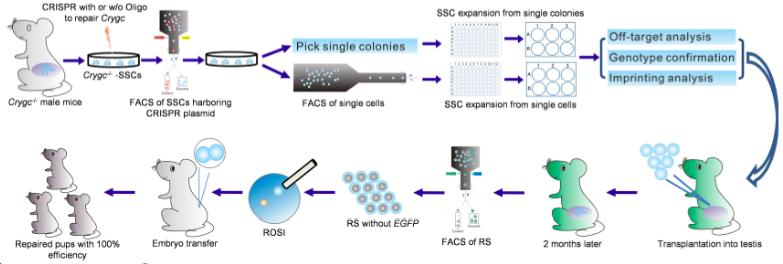
The clustered regularly interspaced short palindromic repeat sequences (CRISPR)-Cas9 system from bacteria has been recently employed in gene therapy. Two studies, one from Dr. LI Jinsong’s lab (Cell Stem Cell, 2013, 13, 659) and the other from Dr. Olson’s lab (Science, 2014, 345, 1184), reported that the CRISPR-Cas9 system, after being injected into zygotes, could correct disease-causing mutations in mice.
However, direct injection of CRISPR-Cas9 system into zygotes could not produce healthy progeny at an efficiency of 100% and could potentially generate off-target modifications. To circumvent these problems, single spermatogonia stem cells (SSCs) harboring genes corrected with CRISPR-Cas9 but without any other unwanted genomic changes were selected, and the SSC lines could be used to produce healthy offspring at 100% efficiency.
Recently, a study from researchers at Shanghai Institutes for Biological Sciences (SIBS) of Chinese Academy of Sciences and Peking University provided proof of principle for using the CRISPR-Cas9 to correct genetic disease through SSCs.
To test the feasibility of the strategy of CRISPR-Cas9-mediated genetic repair in SSCs, WU Yuxuan, ZHOU Hai, FAN Xiaoying, ZHANG Ying, ZHANG Man and their colleagues, led by Drs. LI Jinsong and WU Ligang at Institute of Biochemistry and Cell Biology, SIBS and Dr. TANG Fuchou at Peking University, generated a SSC line from homozygous cataract male (termed Crygc-/--SSCs). After electroporation of CRISPR-Cas9 or CRISP-Cas9 plus exogenous wildetype single-stranded DNA oligonucleotides into Crygc-/--SSCs, they derived multiple SSC lines that carried corrected Crygc gene via NHEJ (non-homologous end joining) or HDR (homology-directed repair)-mediated gene editing.
The researchers analyzed off-target effects in these cells by sequencing predicted potential off-targets loci and by whole-genome sequencing. They studied the imprinting state of these cells by bisulfite analysis of specific imprinting genes and by whole-genome bisulfite sequencing. Fertilization using spermatids derived from these corrected SSC lines gave rise to offspring with the corrected phenotype at an efficiency of 100%.
This work entitled “Correction of a genetic disease by CRISPR-Cas9-mediated gene editing in mouse spermatogonial stem cells” was published in Cell Research on Dec 5, 2014.
This study was supported by grants from the Chinese Academy of Sciences, the Ministry of Science and Technology, the National Natural Science Foundation of China and the Shanghai Municipal Commission for Science and Technology.

Figure: Diagram for the correction of a genetic disease in mouse through CRISPR-Cas9-mediated gene editing in SSCs. (Image by Dr. LI Jinsong)

86-10-68597521 (day)
86-10-68597289 (night)

52 Sanlihe Rd., Xicheng District,
Beijing, China (100864)

